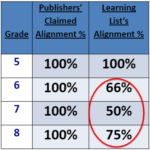According to the 2021 Survey Results of the RAND Corporation’s American Instructional Resources Surveys, over 90% of the teachers surveyed consider standards alignment an important characteristic in their district-provided instructional materials (question 34). Yet, only between 36-41% of the surveyed teachers (depending on the content area) perceive that their district-purchased materials help their students master their state’s math, English language arts, or science standards.

Are materials as poorly aligned as teachers perceive? Learning List has reviewed the alignment of over 3,300 widely used PreK-12 instructional materials. Our subject matter experts review the citations (e.g., lessons, activities, assessments) listed in the publisher’s correlation for alignment to the content, context and cognitive rigor of each standard. We find that core materials are generally aligned to most (though not all) of the standards; the alignment of supplemental materials is much more variable.
So, why do teachers perceive that their core materials are not aligned? Here are three reasons:
(1) Publishers’ definition of “alignment”: A publisher’s definition of “alignment” may not match the district or campus definition. Some publishers include citations in their correlation when any part of a standard is addressed. Teachers quickly see that the material is not aligned in most of the places the publishers cite.
(2) Teachers’ expectations: Many standards have multiple component parts. Some materials address the components of complex standards separately in different locations across the material. When citations listed in the publisher’s correlation address only a portion of the standard several citations listed in the correlation must be used together (i.e., bundled) in order to achieve alignment to the standard.
Other materials may introduce the standard in one chapter, provide practice and reinforcement in another chapter, and assesses mastery of the standard in a third chapter. In this scenario, alignment to the standard is most likely found in the location that assesses mastery and unlikely in the locations where the standard is introduced.
If teachers expect each citation listed in the publisher’s correlation to be fully aligned to the standard, they may perceive the material not to be aligned to the standards when they consider the citations individually.
(3) Teachers’ ability to evaluate alignment: Understanding the concept of alignment is relatively easy; applying the concept is much more difficult. Having interviewed and trained hundreds of educators to review the alignment of materials, we have found that determining whether a material is aligned is a technical skill that few educators have the opportunity or time to hone.
Instead of relying on their district-provided instructional material as the primary resource for the course, increasingly, teachers are using resources that they develop or curate from other teachers. The main reason driving this phenomenon is that teachers do not perceive that the district-provided materials are aligned to their state standards. Learning List provides two types of resources to help educators verify the alignment of their district-provided materials.
First, our independent, standard-by-standard alignment reports for thousands of widely used PreK-12 instructional materials show precisely (1) which citation(s) in the material is/are aligned to each state standard, and (2) which citations are not aligned. If a citation is not aligned, a reviewer’s comment explains which part of the standard the citation fails to address. If multiple citations must be bundled to achieve alignment to a standard, our alignment reports indicate which citations must be “bundled.”
Second, our Alignment Matters, online professional development course, explains what it means to unpack the content, context and cognitive rigor of a standard and provides guided and independent practice to help teachers determine whether a material is aligned to the standard. These two resources give educators more confidence in the alignment of their district-provided instructional materials and hopefully save them the time of curating other resources to use instead.
